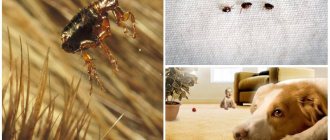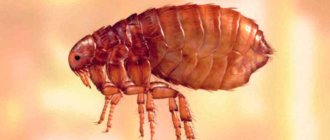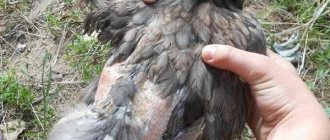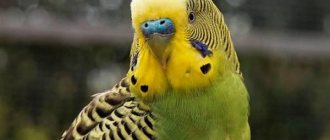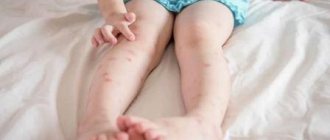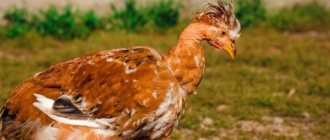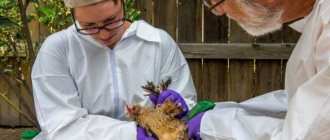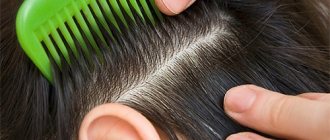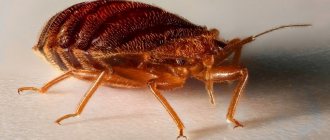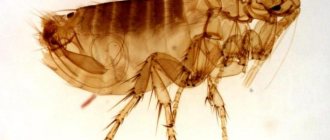Beloved pets often begin to itch after interacting with street animals or traveling to the country. The owner is horrified to discover that fleas live on a cat or dog. Whether they pose a danger to family members is the main question that plagues many. Let's consider whether fleas live on the human body, and what measures need to be taken to rid your pet, yourself and your home of uninvited guests.
- Types of fleas on a dog
- On a cat
- In public
- How to recognize fleas
- Bites in children
- Physiology
- Head disinfection
- Chemicals
Types of fleas
Fleas do not have wings and belong to the blood-sucking order. The body of insects is equipped with special devices (spikes) for attachment to the skin of animals whose blood they feed on. More than 2000 varieties are known. Some species, while not parasitizing on humans, can, if accidentally ingested, establish themselves in a person’s hair or clothing and live in an apartment.
On a dog
Dogs live on parasites called Ctenocephalides canis, or dog flea. This species is widespread everywhere, insects are not picky - they choose cats and rodents to parasitize, and will not refuse to bite a person. They are resistant to poor living conditions; they can live on the body from 3 months to a year and a half.
They spread Marseilles fever, plague, leprosy, and ctenocephalosis. They carry several types of parasites.
On a cat
Cats are favored by the insects Ctenocephalides felis, which also live on other animals and are also dangerous to humans. The bite of such a flea, when scratched, leads to purulent inflammation and a special type of dermatosis.
They carry plague, brucellosis, and rickettsiosis. The individual lives up to 2 years. A very dangerous type of flea, with severe infestation the animal develops anemia and exhaustion.
In public
According to scientists, the homeland of the human flea (Pulex irritans) is South America. In addition to people, it can live on domestic and wild animals. Carries plague and eggs of some parasites.
A skin disease caused by insect bites is called pulicosis. Produces a record number of eggs, laying them in secluded places in basements and quiet attics.
Treatment of bites
To relieve pain and itching, the bite sites are wiped with a cotton swab soaked in boric or ethyl alcohol. The skin can be pre-washed with soapy water. To reduce swelling, apply an ice cube.
All fleas on the human body are removed mechanically: this can be done in the shower with a stream of water, and combed out of the hair with a fine comb.
Antihistamines are used to relieve the symptoms of an allergic reaction.
As an additional therapy, you can use traditional methods: make a compress with a decoction of mint and bird cherry, apply lemon peels or drunk tea.
If, in addition to skin manifestations, there is an increase in temperature, purulent inflammation and enlarged lymph nodes, you need to consult a doctor.
Additional examination may also be required to prevent the development of complications and concomitant diseases carried by parasites.
Symptoms of bites in humans
A person’s reaction to a flea bite depends on the characteristics of the body. Some feel a stabbing sensation at the moment of biting the skin, others experience an unpleasant burning and itching a little later or after finishing sucking.
A flea bite is accompanied by the following symptoms:
- red spots with swelling of the skin at the site of the bite, similar to traces of mosquito bites (up to 5 millimeters);
- swelling surrounding the spot usually goes away after a few hours;
- severe itching, burning, desire to scratch the affected area of the skin.
The spots and itching persist for up to two days. Other reactions largely depend on the individual characteristics of a person. Some develop blisters, noticeable swelling, and hives caused by the enzymes introduced by the flea.
How to recognize fleas
Insects move by jumping; they do not live on the human body, but only feed. Bite sites are most often localized on the ankles, where they are able to jump. If an apartment is infested with fleas, then when a person is sleeping, they can bite him anywhere.
You can detect fleas:
- by the characteristic bite spots that will appear regularly, because individuals need to eat;
- according to the appearance of the discovered insects, the color is brown, size is 2-3 millimeters, the hind legs are longer than the others, there are 6 legs in total;
- scattered eggs of small size and white-transparent appearance - in the folds of furniture and bedspreads, rugs, where pets lie.
There is no doubt that if fleas live in the house, they will reveal themselves. Animals and people will itch constantly. Note that bites usually do not appear under hair; this localization is typical for lice.
Routes of transmission to humans
One should not blame only domestic animals for the appearance of fleas in people, although pets are most often their source. Fluffy fur and corners of sofas favored by pets are the main places where insects get onto humans.
Other sources of bloodsucking:
- livestock and their habitats;
- courtyard buildings;
- non-residential parts of premises - attics, basements, stairs;
- small pets – rats, birds, their cages.
Dirty basements, habitats of street animals and homeless people are usually heavily infested with fleas of various species. Fleas live where warm-blooded creatures live or frequent, giving them food. These can be nurseries for domestic or wild animals, dovecotes, chicken coops.
Habitats
Fleas are almost elusive; swatting them down requires a fair amount of dexterity. A person is a source of food, not a place of permanent residence. At the same time, insects have convenient means on their bodies for attaching to hair and tissues, so they can live in the fur and not leave the animals. People leave after satiation.
Fleas live in close proximity to humans:
- in secluded crevices of furniture and walls;
- in the folds of fabrics, covers, bedspreads;
- close to the habitats of animals and birds.
They love places where people rarely go to clean or ventilate, or move things. They often live in neighboring non-residential premises - closets, utility rooms, sheds.
Where do “uninvited guests” come from?
Most often, ectoparasites live in the basements of houses, from where they ascend into the home for a source of food. They can also settle in attics, where bird nesting areas provide excellent shelter. The human flea is capable of remaining without food for a long time, courageously enduring unfavorable conditions.
Their ways of entering a home are numerous and do not cause any particular difficulties:
- fall with shoes and clothes;
- climb through cracks or ventilation ducts from neighbors;
- transmitted from stray cats or dogs;
- crawl off mice and rats if they appear in apartments;
- jumping through open windows or doors;
- spread from person to person.
It is important to notice the “enemy” in time and get rid of it as soon as possible, otherwise the flea will cause a lot of trouble and trouble to the inhabitants of the home.
Are fleas dangerous for humans?
The question of whether fleas can live on or near a person is extremely important. After all, insects come into contact with sick animals, dirt and infection, and then bite through the skin and come into contact with human blood.
The harm they cause is not limited to itching and discomfort. People who are accustomed to cleanliness and live in comfortable conditions often develop neuroses when insects are found on their clothes or on their heads.
Modern man has come a long way from the times of wars and epidemics, when lice and fleas were everywhere. Most people don't know whether fleas jump or whether similar insects can live in human hair.
It is worth recalling the harm blood-sucking people cause:
- infection, suppuration of wounds, especially when scratching, dermatitis;
- allergy to the bite itself, which can be local or general;
- infections carried by insects;
- spread of parasites.
All these consequences of bites make proximity to insects very dangerous. Having caught on hair or clothing, a flea can enter the house even without pets, which many consider the main source of spread.
Diseases carried by different types of fleas:
- bacterial - plague, listeriosis, salmonellosis, tularemia, yersiniosis, pseudotuberculosis;
- viral – hepatitis B and C, tick-borne encephalitis;
- rickettsia - typhus;
- protozoa – trypanosomiasis.
Insects carry fragments of parasites that can cause intestinal infections.
Bites in children
Children's reactions to flea bites are the most powerful and unpredictable. This is due to:
- delicate skin, inability to resist scratching;
- greater tendency to allergies;
- undeveloped immune system.
Children live in closer contact with animals, including street animals, and are often attacked. Children often develop dermatitis; with significant damage to the skin, the temperature rises and rashes are observed. Children sleep poorly, lose their appetite, develop neurosis and fever.
Vaccinations, which must be carried out at the recommended time, help protect children from severe reactions to insects.
Flea allergy
Allergic reactions are a response to the penetration of foreign substances into the body that are perceived as dangerous. The flea secretes enzymes that enter the blood and spread throughout the body.
It is difficult to predict the consequences of an allergy to these enzymes - reactions can be rapid or delayed. Among the possible:
- skin rashes with itching, dermatitis;
- swelling of the mucous membranes of the nose, throat, eyes with copious secretion of tears or mucus;
- signs of intoxication - shortness of breath, difficulty breathing, headache.
In most cases, taking antihistamines - Loratadine, Diphenhydramine, Terfenadine - helps. In case of significant manifestations, you need to call a doctor or an ambulance to avoid angioedema or anaphylactic shock.
What is histamine
Histamine is a hormone that regulates many processes in the body. Its increased production is triggered by certain diseases and the ingestion of substances that are allergens. For some people, these are flea enzymes.
An increase in histamine synthesis causes muscle spasms, dilation of capillaries, a drop in pressure, increased permeability of the walls of small vessels, swelling and stagnation of fluid in the tissues.
Allergic reactions to flea damage to the skin are caused by increased histamine release.
How to remove human fleas at home
To get rid of human fleas indoors, you should take a whole range of measures:
- do general cleaning;
- wash the floors in all rooms using vinegar (1 tablespoon per liter of water) and a couple of drops of essential oils of lavender, mint and other strong-smelling plants;
- wash baseboards and walls (if the coating allows) at a height of up to 1 m;
- vacuum over all upholstered furniture and carpeting (the disposable dust collector should then be immediately thrown into a trash can outside, and the regular one should be thoroughly drained outside, soaked in water and vinegar (1 tablespoon per liter of water) for an hour, washed and dried;
- wash all bedding and clothing;
- throw away all old unnecessary rags;
- take all blankets, pillows and mattresses out into the bright summer sun or frost for the whole day;
- treat all furry pets, if any, with anti-flea drugs.
After all these measures, you can begin to directly get rid of the bloodsuckers.
Flea remedies for children
In the case of children, the situation with fleas is complicated by the fact that parasite bites can be all over the body due to the child’s small stature. And the first thing to do is to properly treat the wounds so that the child does not scratch them, causing a secondary infection. The following are best suited for treating (lubricating) the affected area:
- aloe vera lotion (optimal for use in infants);
- Hydrocortisone cream;
- if you are prone to allergic reactions, the bite site can be treated with hot and cold compresses with a vinegar solution, which is created by mixing water and vinegar in equal proportions, or with plain water;
- a mixture of essential oils (tea tree oil, almond and coconut oil are mixed in equal parts).
If fleas are jumping in your child's hair, you can use lice treatments sold at the pharmacy. However, before using them, carefully study the instructions to know at what age you can use the drug and its contraindications. Shampoos with tea tree oil and scented lemon soap help get rid of fleas in your hair.
In children, flea bites can be found all over the body due to their short stature
Poisoning with special insecticides
If you want to get rid of parasites with the greatest reliability, you will have to resort to chemical industry products. So, you can use:
- sprays (aerosols);
- powders/dusts, in particular microencapsulated products;
- solutions/concentrates;
- crayons.
Aerosols (sprays)
Such drugs cause the death of insects after entering the respiratory tract. They act most quickly compared to other means and with their help you can get rid of parasites within 24 hours. The most popular drugs are Dichlorvos, Reid, Get, Raptor, Combat.
To use them you need:
- Do a general cleaning of the room.
- Remove food and utensils from the room.
- Move furniture away from the walls.
- Remove all uninvolved persons from the premises.
- Wearing rubber gloves and preferably a respirator (or at least a cotton-gauze bandage), spray the walls with the product at a height of up to 1 meter, carpets and floors, all nooks and crannies and baseboards.
- Leave your home for the time specified in the instructions.
- Perform through ventilation for 12 hours.
- Vacuum and wash floors thoroughly.
- After a week, you can repeat the treatment in case of severe infection.
How to treat a room with flea sprays - photo gallery
After disinfestation is completed, the room must be thoroughly vacuumed to remove dead fleas, eggs and larvae.
During processing, all food must be removed from the premises to prevent toxic substances from getting on them.
Flea sprays are highly toxic, so it is advisable to carry out disinfestation wearing a protective suit, or at least gloves and a respirator.
General cleaning of the premises is necessary in order to get rid of flea eggs and larvae
Different brands of flea sprays have different effectiveness and duration of action.
Powders/dusts
The particular effectiveness of powdered products is due to the fact that they destroy not only adults, but also larvae. This is explained by the fact that small grains are found on organic matter, which the young generation of parasites feed on, and adult fleas collect the toxic substance with their paws and chitinous cover.
Particularly effective are microencapsulated products that adhere to all surfaces. In addition, after a certain time, the capsules burst, and the poison scatters in different directions, greatly enhancing the effect of the drug. Such products as Clean House, Fas-double, Baygon, Tornado are widely used today.
After general cleaning, the powdered product is generously poured into the most secluded places - under the bed, behind the baseboards, in cracks on the floor and in the ceilings (if any). The active properties of the dry powder are maintained for 14 days, after which it is either removed or renewed.
Almost all insecticidal powders for insect pests and parasites are very effective against fleas
In addition, a solution can be made from the substance, which can be used to treat all possible surfaces. For this:
- put on rubber gloves and a respirator;
- dissolve 20–40 g of powder (the amount depends on the degree of infection of the room) in 1 liter of warm water;
- all walls (if permissible), hard furniture, floors are washed with the solution, and the lower part of carpets and animal bedding is treated with it;
- after 4–6 hours, all surfaces are washed with soap and soda solution;
- if necessary, the treatment is repeated after 2 weeks.
To prepare a soap-soda solution, grate 50 g of laundry soap on a coarse grater and dissolve it in hot water (5 l), then add 50 g of baking soda.
Solutions/concentrates
The solutions are most often used by professional exterminators, but you can also use them yourself. Among the popular remedies: Executioner, Sinuzan, Butox-50.
For use:
- do general cleaning;
- move the furniture away from the walls;
- remove all food products and remove children and animals from the premises, as well as all uninvolved persons;
- the product is diluted in water according to the instructions;
- treat all surfaces with it at a height of up to 1 meter;
- leave for the time specified in the instructions;
- After applying the product, do not wash it off for a week.
To get the product into deep crevices, you can use a spray bottle. When processing, be sure to wear rubber gloves to avoid chemical burns.
Flea solutions show high effectiveness, but are highly toxic
Flea crayons
An excellent means of preventing the appearance of fleas are crayons like the well-known “Mashenka”. Draw chalk lines in all secluded places, under the rug near the front door, and so on. This should be done in places inaccessible to children and pets. Crayons can also be used as an aid in the fight against fleas.
Getting rid of fleas with cold
Another fairly effective method of getting rid of human fleas is freezing the premises. True, using it is quite problematic - you may encounter a serious confrontation between neighbors in an apartment building. And it is imperative to warn them, because if your heating pipes burst, they (and you too) will be directly affected. And then you will face not just a loud scandal, but also, most likely, problems with the housing office, and you may have to pay a considerable fine for damaging state property. And in the event of a lawsuit from a neighbor, they will probably have to make repairs at their own expense or compensate for its cost.
Therefore, it is best to use such a tough method of fighting fleas in a private home, following important rules. So, before opening all windows and doors, all utility lines must be thoroughly insulated. To do this, they can be wrapped with heat-insulating material, in extreme cases, foam rubber or old rags.
Fleas die at a temperature of -20 degrees Celsius, and it is clear that it is quite difficult to achieve such a temperature in the house. However, freezing will take effect very quickly - after just 10 minutes of being in such a “freezer” they die. However, we repeat, you will use this method at your own peril and risk.
How to get rid of human fleas using folk remedies
In some cases, it is dangerous to use chemicals in the home due to allergies, small children or pets. And then folk methods come to the rescue. There are several such recipes that can quite effectively get rid of bloodsuckers if their population is not too large.
Herbal infusion
To prepare the infusion you need:
- take 2 teaspoons of tansy and wormwood and 4 teaspoons of eucalyptus (all plants in dry form);
- pour 250 ml of boiling water over the herbs;
- stir and leave to infuse for 10 hours;
- Pour the finished product into a container with a spray bottle and treat walls with it at a height of up to a meter, carpets, floors, upholstered furniture and toys. The pungent smell should drive the parasites out of your home.
Coniferous wood shavings
Pine shavings can be scattered in all corners and stuffed into the animal's bedding. The smell of pine needles is intolerable to fleas.
Citrus peels
Using the skins of oranges, lemons, grapefruits, tangerines, placed in all possible places, you can repel parasites for a long time. In addition, with this product you scent the room.
Garlic
Because of the pungent odor, fleas strongly dislike garlic. To get rid of parasites, it is cleaned, and the cut slices are laid out on all possible surfaces.
Folk remedies for fleas allow you to get rid of parasites without harm to health
Vinegar, cologne and camphor
To use the product:
- mix camphor alcohol, floral cologne and vinegar in equal quantities;
- The solution is sprayed on all carpets, baseboards, cracks and other secluded places.
Soda and salt
To use this product:
- take 2 glasses of water heated to 30–40 degrees and half a glass of soda and salt;
- dilute dry ingredients in water;
- the resulting solution is sprayed onto floors, walls, carpeting, and upholstered furniture;
- a day later they do a high-quality wet cleaning.
In fact, it often turns out that the most popular folk remedies like wormwood and tansy do not have any negative effect on parasites at all. Moreover, dried plants serve as an excellent springboard for fleas to accurately jump onto their prey. And the only consolation can be that by such means you do absolutely no harm to yourself or your loved ones.
By the way, in this article the author does not specifically mention methods such as, for example, spraying with kerosene. From personal experience, we can say that with such substances you will smoke out your household faster than parasites. Also, do not forget that after using such a product, your home is extremely fire hazardous. And getting rid of the pungent smell of this flammable substance is very problematic.
In the cold season, thick woolen tights, knee socks or high socks can be used for mechanical protection against human fleas. Although the parasite jumps quite high, such an obstacle may well prevent it from biting. This type of protection is especially relevant for small children, who can also wear a sweater and pants made of thick material. But in the mid-season period, try smearing your feet with Zvezdochka balm, the pungent smell of which can repel fleas.
Description of insects
The insects' body is smooth and equipped with spines that help them cling to their prey. Fleas have 3 pairs of legs; the rear ones are longer and provide jumping ability. Insects are good jumpers, so they fly to the victim without direct contact.
Body length – 3 millimeters, color – brown. The compressed sides allow for easy movement between hairs. They usually live outside the human body, visiting for food. They jump quickly, up to 50 centimeters. It is difficult to catch and crush an insect.
The eggs are thrown in small batches in different places, sometimes on the host. Larvae hatch, similar to worms, which actively move, live in garbage and dust, and feed on organic debris there.
Physiology
They feed on the blood of warm-blooded creatures, including humans. They can live near people or animals, hiding almost all the time when they are not looking for food.
They live up to 500 days, but usually much less. If they don't find people, they terrorize domestic animals.
Why are they dangerous?
The main threat lies in the diseases that fleas spread. Among the most significant and likely:
- salmonellosis;
- hepatitis;
- helminthiases;
- tick-borne encephalitis.
Even if infection does not occur, many people suffer from skin irritation, peeling, and loss of appearance. Often, especially in children, allergic reactions are added. Unpleasant neighbors can seriously ruin your life, leading to neurosis.
What does a bite look like?
The bite site is a small red bump that rises slightly above the skin. With a large number of wounds, they resemble a large rash. If scratched - swelling of the skin, abraded areas of the epidermis, redness.
Distribution routes
The human flea takes a liking to empty rooms near humans. They live in close proximity and are brought in mainly by the person himself on clothes, shoes, things from the attic or closet.
Fleas move well on their own, they sense where they can feed, so they try to live nearby. They easily migrate from the extreme floors of houses to apartments.
Signs of the presence of a parasite
If fleas have settled down to live in an apartment, it is impossible not to detect their traces. Household members are covered with red spots and itch. Small eggs are easy to spot in different places. Although the tracks resemble those of mosquitoes, flying squeakers are usually detected immediately.
The best way to remove fleas from an apartment
In our practice, in approximately 80% of cases, we carry out flea treatment in apartments whose owners have been trying to remove fleas themselves for a long time and without much effect. Perhaps you shouldn’t waste money and time on fighting fleas on your own, but immediately turn to professionals.
Ours offers the best conditions for services for removing fleas from apartments in St. Petersburg and the Leningrad region. We are a professional SES service, so we can offer a variety of disinfection and disinfestation services. Our company employs only experienced employees who use advanced equipment that helps effectively combat various pests.
Removing fleas from apartments is one of the most frequently ordered disinfestation services; we have managed to remove fleas from the apartments of several hundred clients, providing a 60-day guarantee for each procedure. We successfully work in St. Petersburg and the Leningrad region, treating apartments against fleas with the most effective and harmless means. These parasites can appear not only in the apartment; they are often ordered to be treated in public institutions, entrances of houses, dormitories, etc.
Our prices for services will pleasantly surprise you - they are among the most affordable in St. Petersburg. We carry out work to destroy parasites in accordance with all sanitary rules, so in a few hours your apartment will be available for use again.
Emergency help for bites
The site of any insect bite should be washed well with running water and soap. When scratching, there is a high probability of introducing an infection from a neighboring area of skin.
Any alcohol-containing tinctures or antiseptics are suitable for treatment. You need to lubricate not only the wound, but also the area around it. Applying cold can help reduce itching and burning.
If there are signs of allergy development - severe swelling, sore throat, lacrimation - take an antihistamine.
For severe itching - Golden Star balm, plantain tincture, Fenistil, any remedy available in the home medicine cabinet.
How to protect yourself
Animal owners especially often have to deal with the consequences of fleas. But no one can be immune from insects. If fleas decide to live in a house, comprehensive treatment of the home is needed.
It includes:
- freeing pets from insects:
- washing all bedspreads, blankets, curtains, processing upholstery and covers;
- processing the yard and buildings, cutting the grass;
- dismantling and processing of storage rooms and closets.
You will have to shake up the whole house to prevent contamination of secluded places where insects like to live.
To avoid getting infected, you need to avoid going to landfills and the habitats of stray animals, and avoid contact of domestic cats and dogs with them. Anyone who ends up in such places should be inspected and their clothes should be thoroughly shaken out before returning home.
Head disinfection
Fleas of any kind, including human ones, do not live in human hair. To remove individual individuals, it is enough to wash your hair regularly. It is useful to use tar soap or shampoos that are sold in pharmacies against lice and nits.
Treatment of wounds from bites
Special wound treatment is only relevant in cases of infection and severe scratching. In most cases, wounds heal within 1-3 days without any trace.
If there are signs of an allergy, you should consult an allergist, especially if irritation persists after taking antihistamines.
You can lubricate the damage with the following preparations:
- iodine;
- Calamine;
- Fenistil;
- tinctures of chamomile, plantain.
If severe itching occurs, the doctor may prescribe medications with glucocorticosteroids for local (Sinaflan, Hydrocortisone) or oral use.
It is better not to use such means on your own.
Damage to the nervous system
Damage to the nervous system from fleas Why fleas are dangerous for humans with frequent regular attacks - a disorder of the nervous system. Neuroses often develop in young children. Appears:
- insomnia;
- daytime sleepiness;
- weakness;
- moodiness, irritability:
- bad feeling.
This condition leads to decreased immunity and frequent colds. In difficult situations, the help of specialists is required.
Getting rid of parasites
You cannot live with fleas in the house; you need to get rid of them as soon as the first individual is discovered. General cleaning of the apartment and treatment of animals is required.
Since fleas can live in any place, the main thing is to thoroughly clean all rooms, wash surfaces, and wash things. Bedding and pet houses - change or treat well. Nothing can be excluded; all processing is carried out at one time.
Chemicals
Often only insecticides can completely clean houses of fleas. Let's highlight the best chemicals - ordinary and professional, which will prevent insects from living in the apartment:
- Raptor;
- Pyrethrum – Persian chamomile powder, natural insecticide;
- Combat;
- Biorin, Sinuzan - strong professional products;
- Chlorpirimak is a drug against garden pests;
- Gett;
- Empire 20;
- dust
All of these products require caution when used, but guarantee reliable freedom from all insects.
Folk remedies
Simple folk remedies can relieve itching and irritation. For this use:
- thick soda paste, which is used to lubricate the damage;
- fruit juices – lemon, orange;
- juice of dandelion, marigold, plantain, mint - the leaves must be thoroughly mashed until moisture appears;
- house plants - aloe, kalanchoe - apply leaves or pulp;
- lotions from good tea - not from bags.
These remedies should be used as early as possible.
Professional pest control
If you cannot cope with the flea infestation on your own, you can call special services to clean the area.
They will inform you how to properly prepare for cleansing from parasites and will carry out the necessary measures using insecticides and special equipment for spraying them. They will tell you how to clean the premises after cleaning.
Usually all rooms in the house, the surrounding area and buildings are processed simultaneously. Recommendations are also given for preventing areas where fleas may live.
Treating Pets for Fleas
The main condition for getting rid of human fleas in the house is thorough treatment of pets from parasites and constant protection from them. To do this, you can use a whole range of tools.
Animal treatment products
Modern veterinary medicine offers an impressive range of flea remedies. They are produced in different forms:
- sprays;
- drops;
- shampoos;
- collars;
- injections;
- pills.
Sprays
Flea sprays are quite effective in getting rid of parasites. They contain both flea-killing and flea-repellent substances. In addition, aerosols are easy to use. However, when using such a product, children should not touch the animal within 24 hours after treatment. Sprays can also cause allergies and poisoning in pets if licked off.
To use the aerosol you should:
- secure the animal well so that it does not escape;
- Remove the cap from the bottle and apply the product, directing the stream against the growth of the hair. The spray is not sprayed on the head to avoid poisoning ;
- for the time specified in the instructions, the drug is left on the animal for effect;
- the pet is bathed using regular pet shampoo, without insecticidal additives;
- the animal is dried.
It is advisable to spray the animal with flea spray in the fresh air or in a well-ventilated area.
The product begins to act from the moment of application and the effect lasts for a week or more, depending on the chosen drug.
For the time required for the product to take effect, you need to keep the animal occupied with something, for example, play with it, in order to avoid licking the fur and poisoning.
Drops
Flea drops are a concentrate of substances that are fatal to fleas and as safe as possible for animals. Most often they contain invermectin, permethrin, pyriproxyfen, fipronil. To use the product correctly, you should:
- do not bathe the animal for two or three days before and after the procedure;
- before use, cut off the edge of the ampoule with the product, spread the hair at the withers (closer to the head) and apply the required number of drops;
- After application, the product is lightly rubbed into the animal’s skin;
- It is advisable to carry out the entire procedure wearing rubber gloves;
- After applying the drops, the animal does not need to be combed or touched at all for at least a day.
The product begins to act in the first minutes after the procedure, which must be repeated on average once a month. Some of the most effective products include Beaphar, Hartz, Dana-2 Ultra and Frontline.
Flea drops must be applied as close to the animal’s skull as possible so that it cannot lick them off
Shampoos
Flea shampoo in the form of a shampoo is suitable for frequent use, since it contains substances that are poisonous to parasites in quantities that are safe for animals. Most often, the preparations contain synthetic pyrethroids along with components intended for hair care. To use the product:
- fill a basin or bath (depending on the size of the animal) with warm water (about 40 degrees);
- the animal is placed in a container, and an assistant may be needed to keep it from escaping;
- Squeeze a small amount of shampoo into the palm of your hand and distribute evenly over the coat. At the same time, you need to carefully ensure that the product does not get into your eyes and ears!
- leave the shampoo on the wool for the time specified in the instructions (usually 10 minutes);
- the product is washed off the animal well with warm water;
- Excess water is carefully removed from the wool by running your palm over it and pressing it lightly;
- The animal is thoroughly dried with a towel or cloth.
1-3 days after washing, you need to examine the fur for surviving parasites or for any allergies to the product (red rash on the skin). If live parasites are found, it is advisable to change the product. By the way, it is important to observe the interval between using the same shampoo (most often this is 10 days) so as not to cause poisoning of the animal with the active substance and not to spoil the hair.
When washing your animal with flea shampoo, pay special attention to ensure that the product remains in contact for the correct amount of time.
Collars
A collar is considered the most convenient flea repellent. And indeed, it would seem that it could be simpler - put it on your pet and forget about fleas for at least six months. However, when using it, do not forget that the substances with which the device was treated can cause allergies in the animal. Therefore, it is better not to let your pet out of sight for the first few hours after putting on the collar in order to immediately see signs of an allergic reaction.
Flea collars can be:
- chemical intended for adult animals;
- biological (their base is usually essential oils), which are put on puppies and pregnant animals (if they are not allergic to the components);
- ultrasonic (they are universal in nature, effective, but have a high cost).
The size of the collar must be selected so that a finger fits freely between it and the pet’s neck. While using the device, you cannot use other flea remedies so as not to cause an overdose of toxic substances in the animal.
Injections
The flea injection has a wide spectrum of action and also allows you to get rid of many other ecto- (external) and endoparasites (internal) - ticks, worms, etc. The active substance, together with the victim’s blood, enters the parasite’s body and causes paralysis and death. The injection most often contains lufenuron, ivermectin or eprimec.
It is worth noting that the eggs inside a pregnant female become non-viable, and the larvae that have already hatched from the eggs will die after the first bite. The validity of the injection ranges from 1 to 6 months depending on the manufacturer. The injection is given into the inner part of the shoulder joint or forearm. Injections should not be given to pregnant, lactating animals and small pets under 3 months of age, as well as elderly, sick and convalescent pets.
Pills
This fairly new flea remedy is quite popular because... easy to use and effective. The tablets usually contain the substance spinosad, which enters the blood through the intestinal mucosa. It causes parasites to paralyze and die after a bite.
The tablet is given along with food, although it is quite edible in itself, thanks to its attractive taste and smell for animals. If the pet does not swallow it, you can give another tablet. It is not advisable to give a flea tablet to:
- animals under 3 months of age;
- pregnant and lactating females;
- weakened, sick or elderly pets;
- those suffering from epilepsy and diseases of the nervous system.
The product can be used no more than once a month. To increase effectiveness, tablets can be combined with external flea medications - drops, collars and sprays. Popular brands of tablets are Sentinel Flavor Tabs, Bravecto, Comfortis.
Prevention
To avoid flea infestation, you need to follow simple measures:
- regularly check and clean pets from insects, as human fleas can live on them;
- to protect premises, use preventive measures - cleaning with disinfectants, spraying solutions of tansy, wormwood, clearing debris and dirt from places where fleas can live;
- use repellents when in potentially dangerous places.
In most cases, fleas are brought by pets; insects prefer to live in their warm skins. Therefore, buy a special collar for your animal and make sure that it does not come into contact with other people’s cats or dogs.
Fleas have long been a real curse of people, spreading epidemics of plague and other dangerous diseases. Modern means create a reliable barrier against all insects, but we must not lose vigilance, since at the slightest mistake, fleas will happily enter our homes.
Where do fleas come from in the house?
This is the first question that torments the owners of an apartment that has suffered from an invasion of small jumping bloodsuckers. If there is a pet in the house that roams freely on the street, the answer is obvious. If you do not keep pets, the infection of the apartment could occur through the basement. Warm, humid, with a minimum of disturbing factors - these are ideal conditions for the reproduction of fleas. Possessing incredible jumping ability, insects easily move across floors on shoes or on dogs walking with their owners, looking into apartments along the way.
